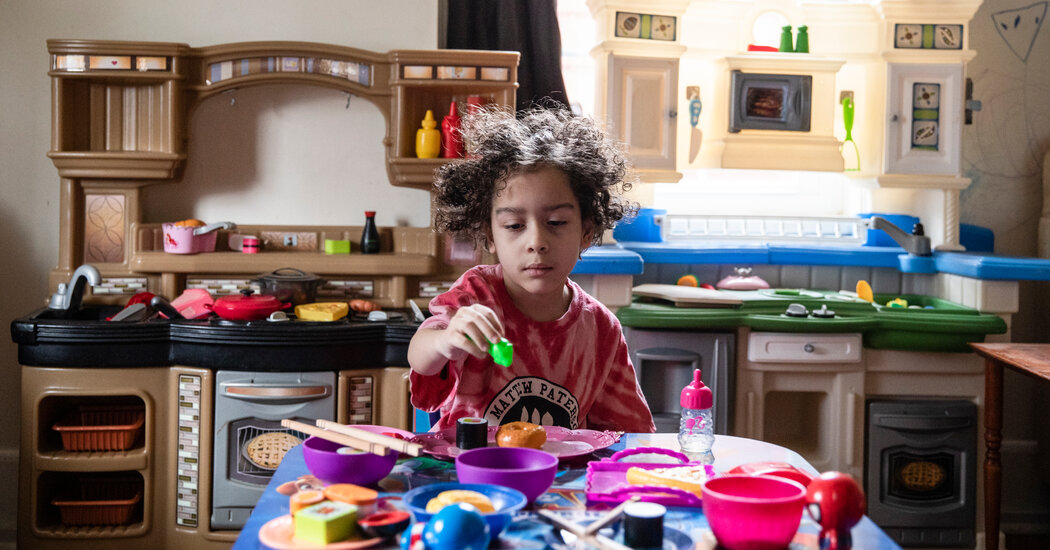
At home in Patterson, N.Y., Rebecca Rivera’s 6-year-old son, Sergio, likes to play chef with his stuffed animals. He feeds them sushi made of wood, and gives his favorite salmon nigiri pieces to Sonic the Hedgehog and Mario, his most beloved toys. Intrigued and inspired by his playtime, Sergio asked his mother if sushi was real — and if he could try it at a restaurant.
Parents across North America are eagerly buying their children food toys that reflect their own increasingly global tastes and evolving dining habits, and toy companies have taken notice. They’ve expanded their offerings exponentially in the past decade, with felt soft-shell tacos, plastic dim sum, plush charcuterie boards and, of course, wooden sushi like Sergio’s.
“The children of today are growing up in a much more connected world,” said Tom Runtz, the director of product development at Learning Resources, which sells toys that replicate fish cakes, ramen, edamame and samosas.
Companies like Melissa & Doug, Little Tikes, KiwiCo and Learning Resources may make toys for kids, but the products ultimately need to appeal to parents. By emulating foods that are gaining popularity in the United States, they are. If you can convince Mom or Dad that it would be cute for their child to make a pretend cappuccino on a toy espresso machine, you’ll make a sale.
“So much of this is also dictated by the Instagrammable culture that we’re in,” said Mark Morse, the vice president of global marketing at Little Tikes. “We’re making purchases based on what we think would be a funny picture.”
Many parents say it’s about much more than that: These toys have made their children more interested in trying new foods and learning about their cultural significance. Ms. Rivera, 36, said her son’s sushi kit has opened a whole new world for him.
“Now he’s curious about Japan and what else they eat,” Ms. Rivera. “Those questions open up a whole palette of food that he can eat.”
It typically takes more than a year for toy developers to bring a new product to market, so designers must be choosy about what foods to replicate. Companies prioritize creating toys that reflect significant changes in eating habits, like the growing popularity of food trucks, delivery apps and milk alternatives. Developers conduct brainstorming sessions, take pictures of foods they’re trying to replicate, carefully design several prototypes to be safe for specific age groups, and test the products with parents and children.
“We have to be careful because the TikTok trend of tomorrow isn’t going to be a trend 18 months from now,” Mr. Runtz said. “We’re going to look like someone that’s late to the party.”
Toy designers also must carefully consider how to accurately present cultural foods to children. The items in a Melissa & Doug taco set, for example, are labeled in English and Spanish. Sofia Dumery, the company’s vice president of design, said developers were cautious in naming those items — for example, referring to the dish’s smooth, white topping as crema instead of sour cream.
“There’s no more common language than food,” she said. “And it’s a really great way to learn about the world.”
Kathleen Gaceta’s 3-year-old son, Camden, can learn about the Filipino food his family cooks at home in Federal Way, Wash., with a colorful puzzle that includes adobo rice, halo halo and lumpia pieces.
“I really like the fact that there’s more cultural representation” in food toys, said Ms. Gaceta, 36. “And if I needed to teach him more about our culture, there are more learning resources and tools that I can use. It makes teaching heritage a lot easier.”
Toy sets like these have also helped Camden, who is autistic, overcome some sensitivities he has to the texture, taste, smell and appearance of certain foods.
While pretend play has always been an important stage of child development, the toys themselves may not change the way a kid eats. They could help introduce children to new foods, but these interactions should be accompanied by the actual meals, said Deena Weisberg, a psychological and brain sciences professor at Villanova University. Food toys can prepare children for social settings — like restaurants — where they’ll eat those foods, and help them make sense of their world.
If the goal is to try to diversify a child’s palate, she said, “it might be better to do it for real.”
At their home in Regina, Saskatchewan, Miranda Anholt’s 3-year-old daughter, Rory, asked to try avocado once she had layered wooden slices of it into her play tacos. “I had never eaten an avocado in my life,” said Ms. Anholt, 27, who has a TikTok account where she posts A.S.M.R. videos with food toys. Mother and daughter tried one together, and Rory loved it.
Motivated to teach her children about their Chinese and Vietnamese heritage (and her own childhood in Denmark), Eveline Tien, 37, has toys at her home in Seattle that resemble dumplings. But she would like to see even more options become available.
“There’s many smaller cultures that haven’t been represented in any way,” she said.
Ms. Rivera, who is Puerto Rican, agrees. “A taco kit is great,” she said, “but not every Latino household has tacos.”



